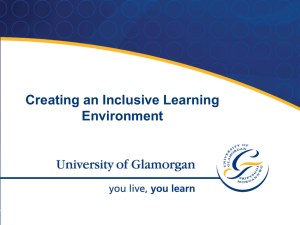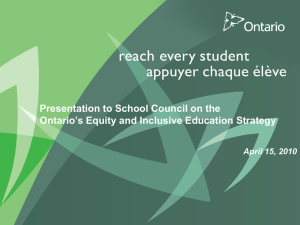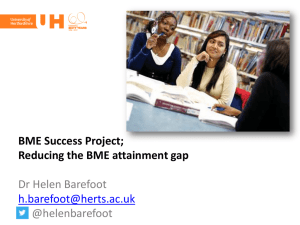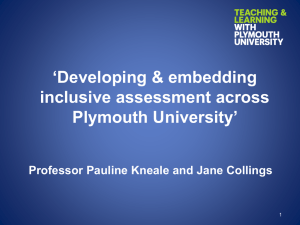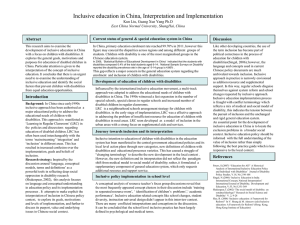Multicultural Group Work - StudyNet
advertisement
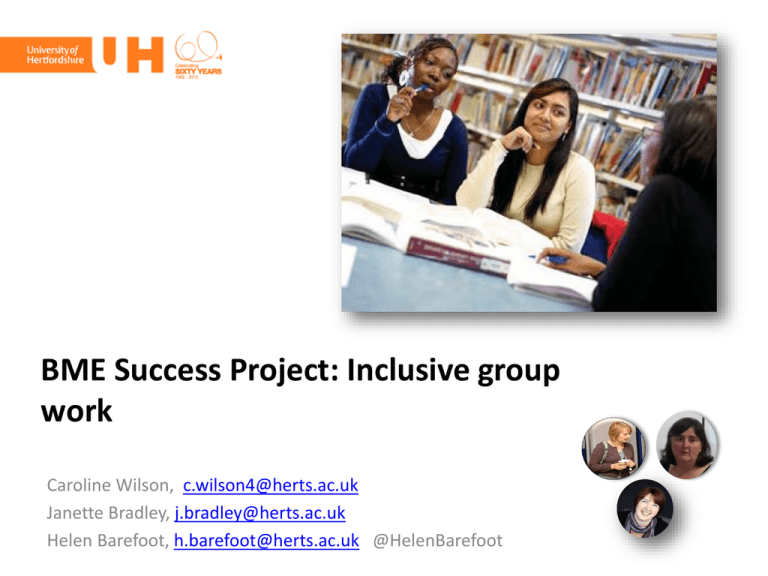
BME Success Project: Inclusive group work Caroline Wilson, c.wilson4@herts.ac.uk Janette Bradley, j.bradley@herts.ac.uk Helen Barefoot, h.barefoot@herts.ac.uk @HelenBarefoot Moving outside the comfort zone o Business School Level 5 Marketing modules 20-30 students per tutorial; o Large international presence; multi-cultural backgrounds; o Diversity of ethnicity within British nationals; o Students tend to sit in friendship groups based around common ground and experiences, especially nationality. Multicultural Group Work It encourages co-operation among students; It encourages active learning. Done well It respects diverse talents and ways of learning; Encourages international discourse; Breaks down cultural barriers; Discourages the teacher from being drawn into only addressing ‘home’ students; Builds interpersonal and communications skills amongst students. Multicultural Group work “The classroom is the main location where students can find ‘common ground’ … they share a subject and a learning environment. As a location it presents opportunities for international and domestic students to make contact and interact in ways that can enhance learning, and academics can organise their teaching and assessment tasks to support interaction.” (Arkoudis, S. et al., The Australian Learning and Teaching Council, 2010) Inclusive environments I manage the learning environment to enable all students to participate fully. I use group activities to facilitate students’ understanding of how working with people of diverse backgrounds enriches their own learning. Provides environments for effective learning for all I structure my teaching activities to enable all students to share their values and beliefs within a culture of mutual respect and dignity for all. Multicultural Group work The Australian Learning and Teaching Council (ALTC) devised the Interaction for Learning Framework Dimension 1 Planning interaction Dimension 2 Creating environments for interaction Dimension 6 Fostering Communities of Learners Dimension 5 Developing reflexive process Dimension 4 Engaging with subject knowledge Dimension 3 Supporting interaction (Arkoudis , S. et al,. The Australian Learning and Teaching Council, 2010) Multicultural Groups – Some observations • It is very easy to just let students form friendship groups • Friendship groups tend to be based around common ground, especially nationality • Friendships can make learning easier, especially for international students who can use their own language • However, they do not encourage diversity of learning or inclusivity Facilitating Group Work o Students often enter a tutorial room which is set up in lines and arrange themselves in friendship groups of like people Tutor’s desk o And if the room is set up for group work students will usually sit with their friends Tutor’s desk Inclusive group work 4 3 4 3 5 2 1 1 4 1 5 2 2 2 3 5 3 1 2 1 3 5 4 4 5 5 4 3 1 2 Tutor’s desk •Set first task in pairs e.g. checking understanding of previous seminars •Set next task in 3s and give people roles in the group Arranging multi-cultural groups - tips • Explain to the students why you are managing the groups and share the benefits they will gain from working with and learning from other people of different cultures • Make sure the tasks are structured • The tutor should be constantly walking around the groups to spot any individuals who may not be engaging and support them to get involved in the task. • This technique can work well when alternated with weeks of allowing work in friendship groups • Name badges are really useful when mixing up the groups to help you get to know the students and to help the students get to know each other. Observations and Outcomes High levels of interactivity: the most vibrant of classes taught; Pace of learning increased: students more productive outside their friendship groups; Expectations raised - impact on attitude and performance? Very positive relationship between students and tutor; Students began to relate to each other differently and take notice of previously ‘overlooked’ individuals; Average individual coursework result 55% Cohort average 49%. “ The structure of the tutorial is good because we are allocated to different groups each week, and it allows us to mix in with different people with different backgrounds and ideas.” Inclusive Group Work helps develop our Graduate Attributes Employability Social responsibility Respect for others Useful resources • University of Hertfordshire Curriculum Design Toolkit Inclusive Culture project work • Guidance on teaching in racially diverse classrooms on Harvard’s website (The Derek Bok Centre for Teaching and Learning): TEACHING IN RACIALLY DIVERSE COLLEGE CLASSROOMS • Guidance on many aspects associated with inclusive teaching from Sheffield University's Centre for Excellence in Inclusive Teaching (including case studies plus hints and tips) http://www.shef.ac.uk/lets/projects/inclusivelandt • The Open University's guidance on Inclusive teaching http://www.open.ac.uk/inclusiveteaching/index.php • The Higher Education Academy's weblinks to Inclusive Teaching http://www.heacademy.ac.uk/resources/detail/subjects/psychology/Teaching_practice_i ssues_Accessibility_and_Inclusive_Practice Useful references • Aguirre, A Jr and Martinez, R (2002) Leadership Practice and Diversity in Higher Education: Transitional and Transformational Frameworks. The Journal of Leadership Studies 8(3): 5362 • Arkoudis, S, et al, (2010), Finding Common Ground: enhancing interaction between domestic and international students, Australian Learning and Teaching Council • Baez, B (2000) Diversity and it’s Contradictions. Academe 86: 43-47 • Bourke, B. (2010) Experiences of black students in multiple cultural spaces at a predominantly white institution, in Journal of Diversity in Higher Education, vol.3, no.2, pp.126-136 • Ellis, S.J. (2009) Diversity and inclusivity at university: a survey of the experiences of lesbian, gay, bisexual and trans (LGBT) students in the UK, in Higher Education, vol.57, no.6, pp.723-739 • Holloway, S. (2001) The experiences of higher education from the perspective of disabled students, in Disability and Society, vol.16, no.4, pp.597-615 • May, H (2010) Towards an Inclusive Culture: Engaging Students in Institutional Enhancement. Presentation accessed via www.heacademy.ac.uk Dec 2010 • May, H and Bridger, K (2010) Developing and embedding inclusive policy and practice in higher education. York: Higher Education Academy.





